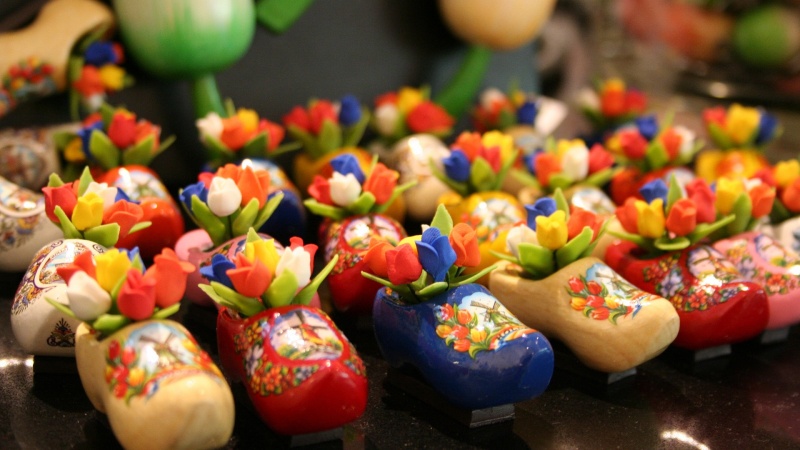Traditional Dutch Souvenirs

So you've visited the Netherlands. You saw the sights, you took some photos, and now you want something tangible to take back with you. You could buy the usual postcards, key rings or magnets, but how about something more typically Dutch?
Clogs
Called "klompen" in Dutch, they often come painted in colourful patterns, but are also available in natural wooden colours.
Although you won't see any clog wearers in Amsterdam, klompen had a practical use for farmers in rural areas of the Netherlands. Dutch clogs were traditionally used to cover feet while working in muddy fields and as protection in cold temperatures. The oldest known clogs date back to the year 1230 and were found in Amsterdam.
If you want to see clog making in action, the Zaanse Schans is definitely worth a visit. This charming little village is only 20 kilometres away from Amsterdam and has a wooden shoe workshop. Here you can see live clog making demonstrations, a wooden shoe museum, and of course, a clog shop.
Tulip bulbs
The tulip was introduced to the Netherlands in the 16th century from Turkey, and quickly triggered a period from 1634 to 1637 called "tulip mania". During this time, tulips became a status symbol and were incredibly expensive in the Netherlands. With prices for a single bulb exceeding a person's average annual income.
These days, tulips are much more affordable and they make a great gift to take home. Get your flower bulbs at The Flower Market, the world's only floating market for flowers. Make sure you get packages that are sealed and approved for import into your home country.
Delft Blue
Delftware are the famous blue and white hand-painted pottery pieces that are iconic to the Netherlands. They are available in many forms, including plates, small figurines and tiles.
Delftware was inspired by Chinese porcelain, which was imported in the early 17th century. The finer pieces of Delft earthenware were produced in the town Delft, and the Royal Delft factory from 1653 is still active today.
The Royal Delft Experience in Amsterdam (www.royaldelftexperience.nl) offers its own take of the original factory in Delft. Located at Muntplein 12 (opposite the Flower Market), a visit includes a tour explaining the history and production process of Delftware, a live Delft painter, a showroom of antique works and a souvenir shop.
Diamonds
For those with a lot of money to spend, a diamond is a classy and timeless gift that has a solid place in Dutch history. You can find competitive prices at Amsterdam diamonds and jewellery stores.
The Amsterdam diamond industry has been a centre for diamond trade and industry since the late 16th century, when Jewish people settled in the city and took up diamond cutting and polishing as their professions.
There are now several diamond factories in Amsterdam. Many of them offer free guided tours, and you will get a full description of any purchases you wish to make.
Jenever
Make an impressive addition to your liquor collection with a bottle of Jenever, the original gin. This classic Dutch drink is available in "jonge" (young) or "oude" (old) varieties, with these descriptions referring to the taste of the genever and not the age of the drink.
Bols is the world's oldest distilled spirit brand and was established in Amsterdam in 1575, with its first genever made in 1664. The House of Bols on Museumplein offers an innovative tour and sells its range of genever products in their Bols Shop.
